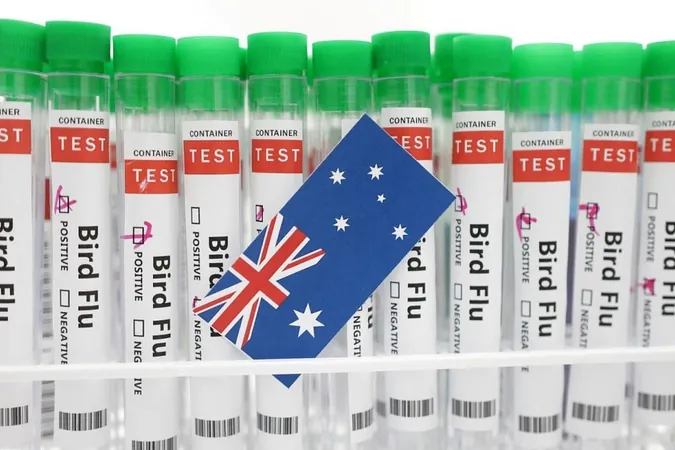
A Countdown to Crisis: Australia and New Zealand Gear Up for Potential Bird Flu Invasion
2024-10-09
Author: Rajesh
Introduction
CANBERRA/WELLINGTON – As the threat of a devastating bird flu strain looms closer, Australia and New Zealand are on high alert, employing stringent biosecurity measures on farms, testing migratory shorebirds for the virus, and rolling out vaccines for at-risk species.
The Threat of H5N1
The H5N1 clade 2.3.4.4b avian influenza has wreaked havoc across Asia, Europe, and Africa since its emergence in 2020, claiming hundreds of millions of birds and tens of thousands of mammals. This epidemic has led to alarming scenarios, such as littered beaches filled with corpses and disruptions to the agricultural sector.
Geographical Vulnerability
Despite their geographic advantage – being removed from significant bird migration paths – Oceania is not invincible. The virus has already reached Indonesia in 2022 and Antarctica in 2023, escalating fears of its potential arrival on Australian and New Zealand shores. Experts warn that the risk is amplified as smaller migratory shorebirds begin their seasonal movements from September to November in the Southern Hemisphere.
Impact on Biodiversity
“It is clearly a threat to our country’s ecosystems,” stated Ms. Fiona Fraser, Australia’s Threatened Species Commissioner, emphasizing the unique biodiversity at stake. “Many of our species are found nowhere else in the world. Vulnerable species may face long-term population setbacks and heightened risk of extinction.”
Predictions and Economic Impact
A particularly concerning prediction paints a grim picture of mass die-offs across various species, including endangered marine life like sea lions and black swans, as well as devastating impacts on poultry farms. The crisis has already claimed over 100 million chickens and turkeys in the United States, resulting in economic losses surpassing US$3 billion by the end of 2023, according to the Council of Foreign Relations. In South America, the virus has decimated around 50,000 seals and sea lions, alongside half a million wild birds.
Preparations by New Zealand and Australia
New Zealand’s Chief Veterinary Officer, Ms. Mary van Andel, echoed these sentiments, reinforcing that geographic isolation may not provide eternal protection from the virus. “We can’t rely on it forever,” she cautioned. Both nations are ramping up their preparedness as if entering a wartime scenario. Australia has formed a dedicated task force involving multiple government departments and conducted simulations of an H5N1 outbreak among wildlife. New Zealand has embarked on trials for vaccines on endangered native birds, signaling a proactive stance against the imminent threat.
Farmers' Response
Farmers are also strengthening their biosecurity protocols, implementing measures such as restricting poultry access to wild birds, closely monitoring staff movements, sterilizing equipment, and integrating automated systems designed to deter wild birds. Australian farms have seen outbreaks of less-virulent strains before; nonetheless, the looming threat of a more aggressive variant raises alarm.
Learning from Others
Meanwhile, New Zealand, which has not previously encountered high pathogenicity bird flu, is taking cues from Australia and Britain, with its Poultry Industry Association facilitating trips for learning and knowledge exchange. “We’ve been at peacetime,” said Michael Brooks, executive director of the Poultry Industry Association in New Zealand. “Now, we’re potentially heading to wartime.”
The Urgency of Action
Although Oceania has enjoyed a longer preparation window compared to other regions, the stark reality remains: wild populations cannot be contained like farms. As Brant Smith from Australia’s Agriculture Ministry pointed out, “Every single continent has seen huge mortality events in wildlife. We are likely to see this occur here, too.”
Conclusion
With the clock ticking and the specter of bird flu looming larger, both Australia and New Zealand are engaged in a race against time to protect their unique ecosystems and food supplies. Will their efforts be enough to stave off a potentially catastrophic outbreak? Only time will tell.



 Brasil (PT)
Brasil (PT)
 Canada (EN)
Canada (EN)
 Chile (ES)
Chile (ES)
 España (ES)
España (ES)
 France (FR)
France (FR)
 Hong Kong (EN)
Hong Kong (EN)
 Italia (IT)
Italia (IT)
 日本 (JA)
日本 (JA)
 Magyarország (HU)
Magyarország (HU)
 Norge (NO)
Norge (NO)
 Polska (PL)
Polska (PL)
 Schweiz (DE)
Schweiz (DE)
 Singapore (EN)
Singapore (EN)
 Sverige (SV)
Sverige (SV)
 Suomi (FI)
Suomi (FI)
 Türkiye (TR)
Türkiye (TR)